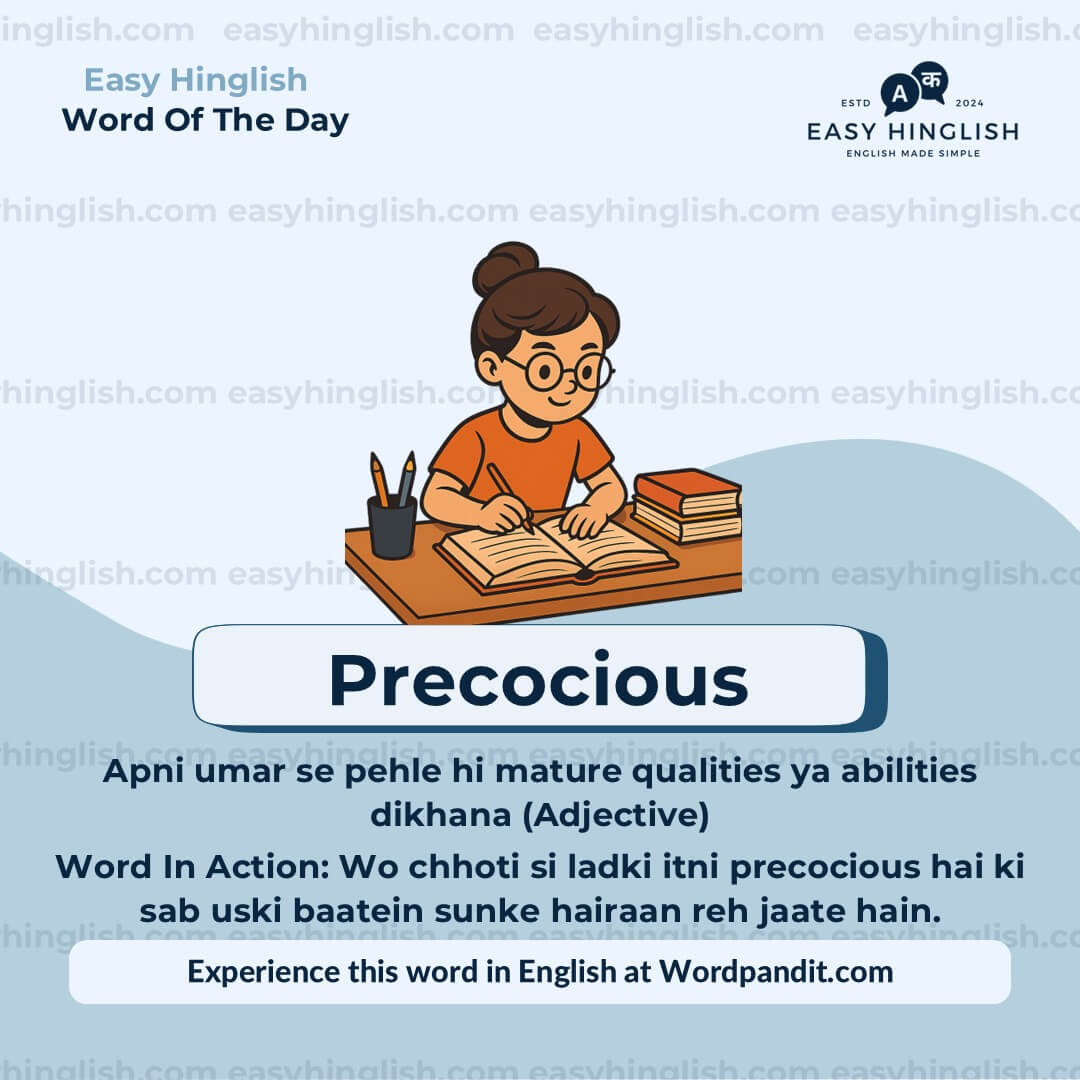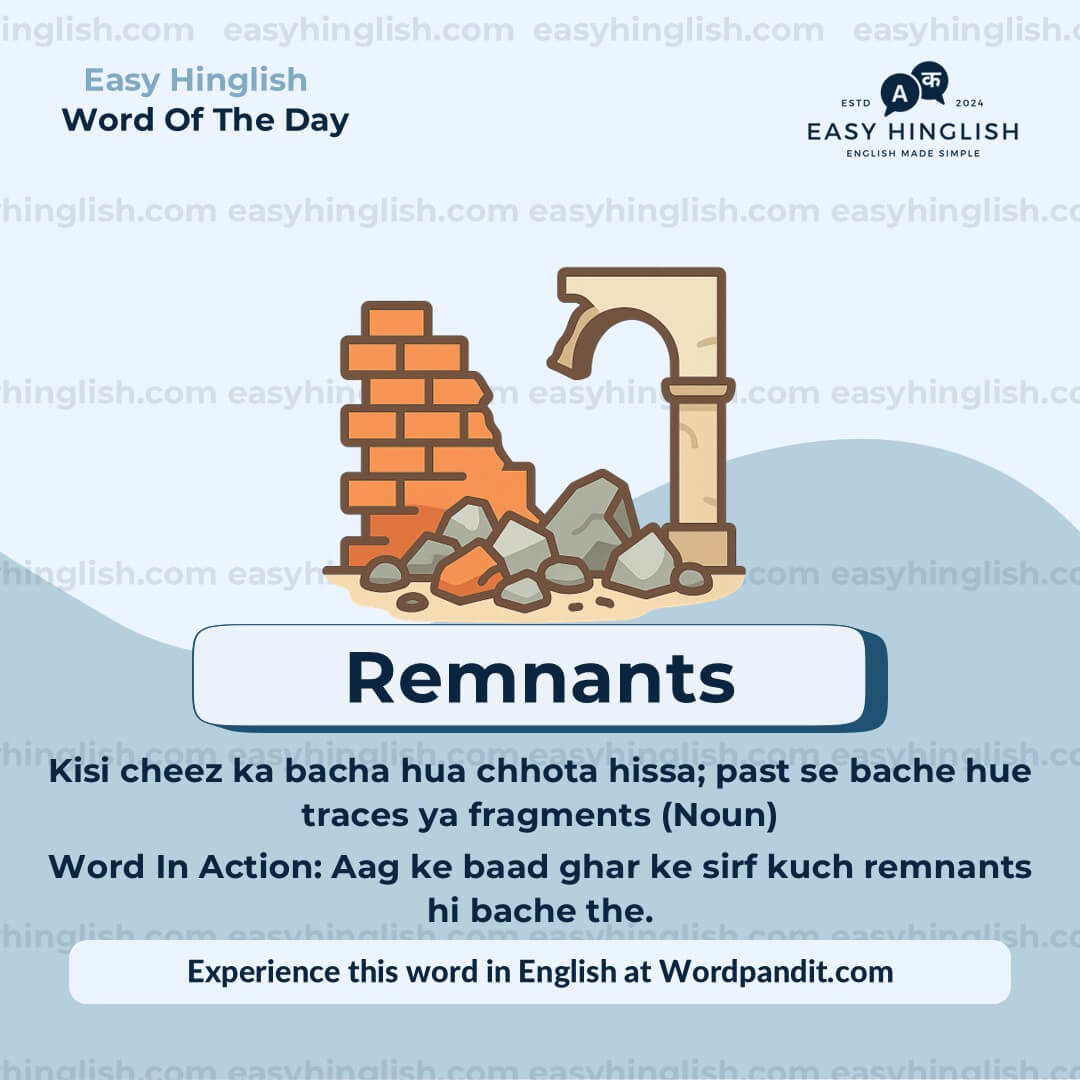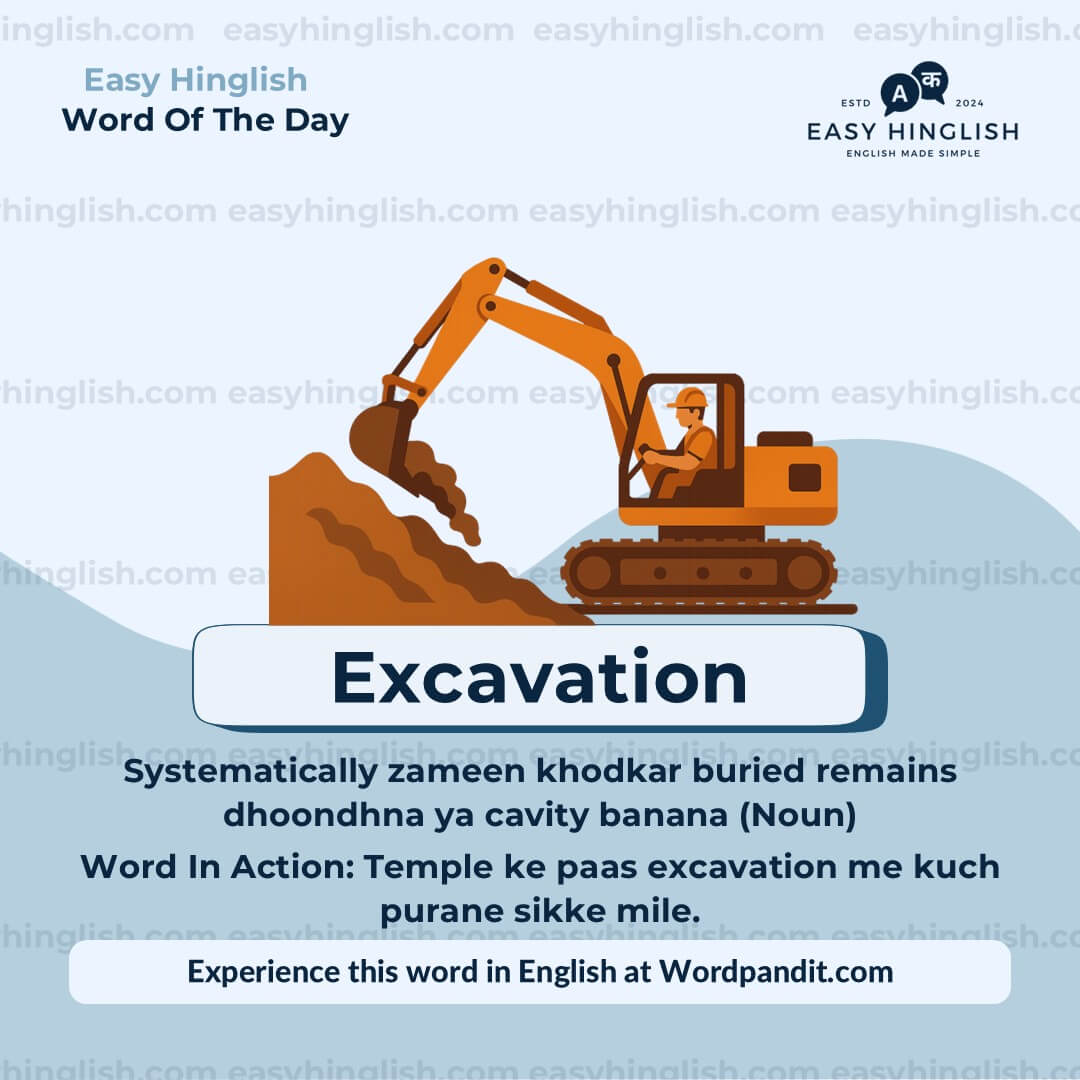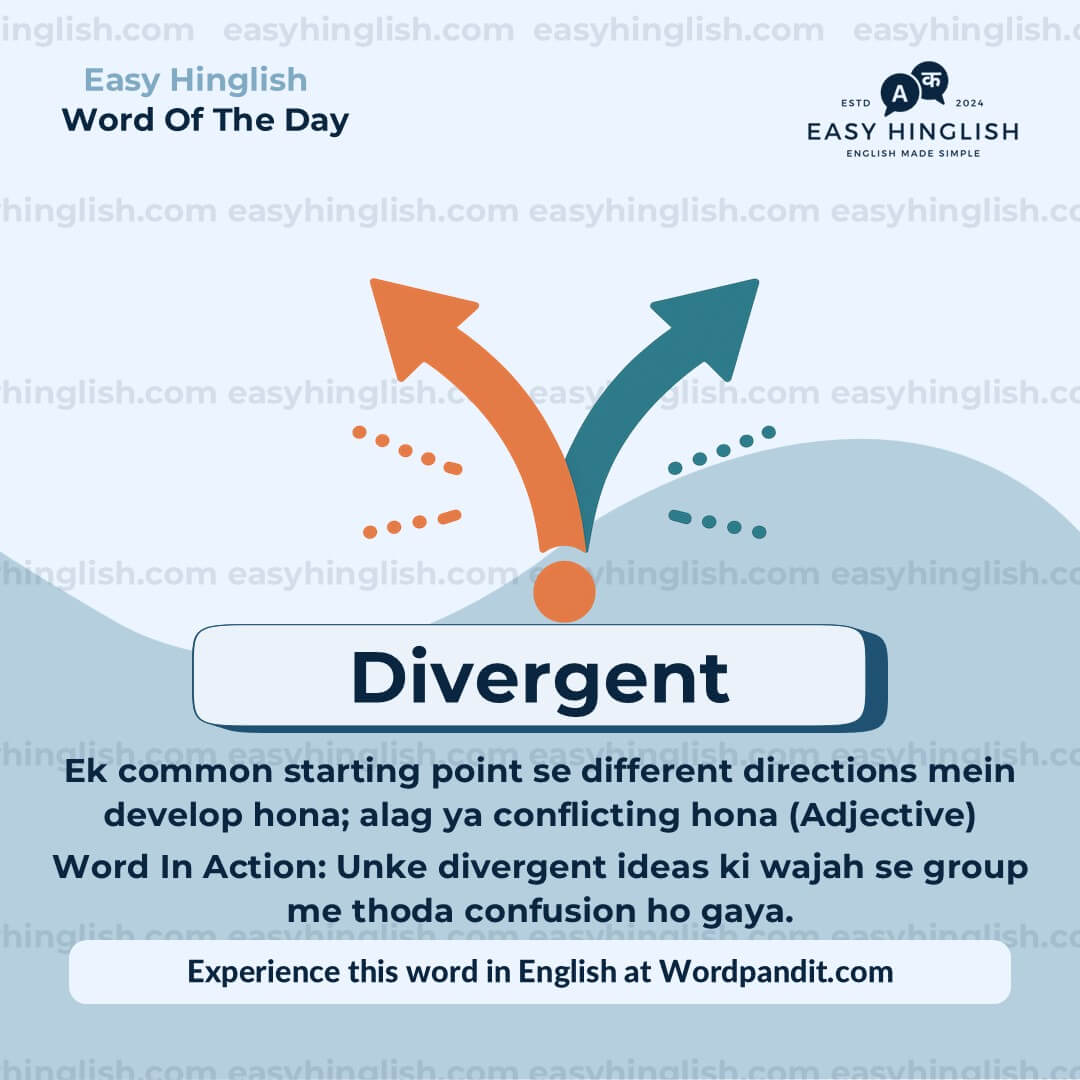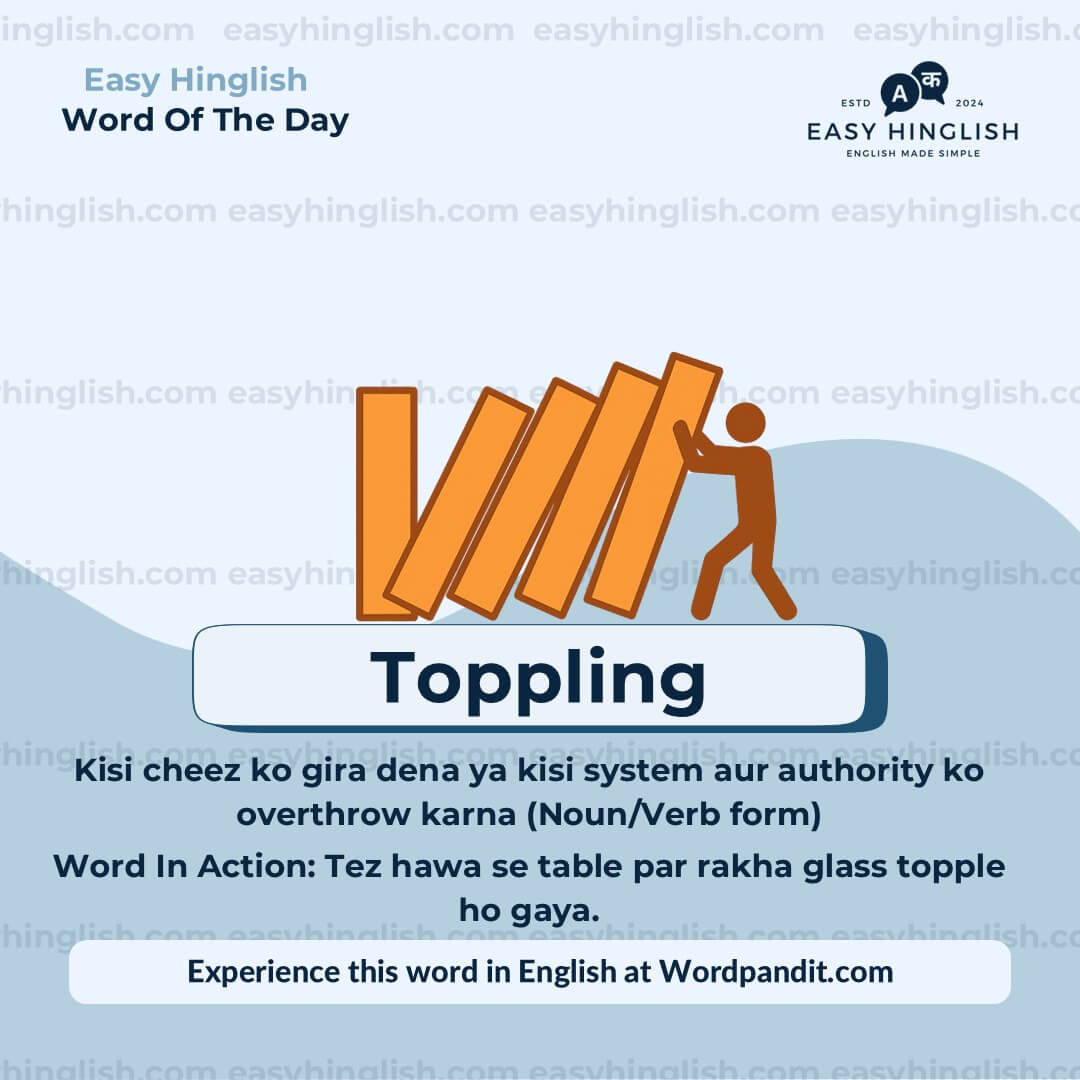Daily Vocabulary Indian Newspapers aur Publications se Seekho
Welcome to Wordpandit ka Indian Vocabulary Hub
Wordpandit par, hum samajhte hain ki ek achhi vocabulary develop karne ke liye local context samajhna bhi zaroori hai. Is section ka focus hai aapke vocabulary ko India ke leading newspapers aur publications se naye shabdon aur phrases ke zariye improve karna, taaki aap practical, relevant, aur uniquely Indian words seekh sakein.
Indian Sources Itne Important Kyun Hain?
Hum maante hain ki kisi bhi language ko sikhne ka sabse best tareeka hai uske local content me immerse hona. Isi wajah se hum carefully words curate karte hain top Indian newspapers aur publications se, jaise:
- The Hindu
- The Times of India
- The Economic Times
- Hindustan Times
- Live Mint
- The Indian Express
- Aur bhi bahut saare...
Hamesha Updated Raho, Hamesha Relevant Raho
Daily updates ke saath, aap Indian news sources se naye words seekhoge jo Indian society aur culture ke latest trends ko reflect karte hain. Hamara focus hai aise words provide karna jo aapke liye real-world me useful ho.
Wordpandit Aapke Learning Goals Ko Kaise Support Karta Hai?
Chahe aap exams ki preparation kar rahe ho, professional communication improve karna chahte ho, ya sirf naye words seekhna chahte ho, Wordpandit har step par aapki madad karega.
Practical Tareeke Se Seekho
Hamari interactive learning methodology me real-world examples, engaging activities, aur context-based usage shamil hain, taaki har naya shabd aapki active vocabulary ka hissa ban sake.
Aaj Hi Indian Vocabulary Seekhna Shuru Karo!
Wordpandit Kyun Choose Karein?
Practical Learning: Aise words seekho jo aapko real-world reading aur communication me sach me kaam aayenge, taaki aapki comprehension aur bolne ki skills improve ho.
Diverse Content: Current affairs se lekar scientific breakthroughs tak, hamare different sources aapko multiple domains ka vocabulary sikhate hain.
Effortless Integration: Wordpandit ko apni daily routine ka part banao. Sirf kuch minute har din dene se aapki vocabulary time ke saath kaafi improve ho sakti hai.
Aapka Vocabulary Mastery Tak Ka Safar
- Regularly hamare Daily Vocabulary section ko visit karo
- Naye words explore karo aur unka context me use samjho
- In words ko apni writing aur bolne ki practice me use karne ki koshish karo
- Jaise-jaise aapke words badhte hain, apni progress ko track karo
Aaj Se Apni Vocabulary Journey Shuru Karo!
Wordpandit ke saath vocabulary improve karna start karo. Roz thoda effort dalne se aap ek strong vocabulary develop kar sakte ho jo academic, professional, aur personal life me kaafi kaam aayegi.
Yaad rakho, ek naya shabd roz seekhna linguistic limitations ko door karne ka best tareeka hai! Wordpandit ko apni daily learning journey ka sathi banao aur vocabulary excellence ki taraf badho!
WORD-1: Precocious
Sandarbh (Context):
"Idiot savant ne in class stereotypes ko reinforce kiya: unke talents, chahe kitne bhi precocious kyun na ho, useless the." - The Wire
Vyakhya (Explanatory Paragraph):
Precocious ka matlab hai 'apni umar se pehle hi zyada samajhdaar ya talented hona.' Yeh word tab use hota hai jab bachche ya young log apni age ke compared mein bahut zyada advanced abilities ya maturity dikhate hain. Precocious ka upyog formal writing, educational assessments, aur competitive exam passages mein hota hai jahan character descriptions mein exceptional early development highlight karni ho. CAT RC passages mein precocious aksar child prodigies, education systems, ya developmental psychology ke context mein milta hai.
Arth (Meaning): Apni umar se pehle hi mature qualities ya abilities dikhana (Adjective)
Uccharan (Pronunciation): prih-KOH-shus (प्रिकोशस)
Kathinai Star (Difficulty Level): ⭐⭐⭐ Intermediate
Utpatti (Etymology): Precocious Latin word 'praecox' se aaya hai jiska matlab hai 'jaldi pakna,' jo 'prae' (pehle) aur 'coquere' (pakana ya ripen hona) se bana hai. Originally yeh word fruits ke liye use hota tha jo expected time se pehle pak jaate the, aur baad mein yeh bachcho ke liye use hone laga jo intellectually ya socially apne peers se aage mature ho jaate the. Yeh botanical origin perfectly capture karta hai early blooming potential ka essence.
Prashant Sir Ke Tathya (Prashant Sir's Notes):
Bahut students precocious ko sirf 'intelligent' samajhte hain—lekin precocious aur intelligent mein farak yeh hai ki precocious specifically emphasize karta hai unusually early development ko, na ki sirf high ability ko. CAT aur GRE ke students ke liye, precocious aksar childhood development, education systems, ya exceptional individuals ki biographical sketches wale passages mein dikhta hai. Indian newspapers mein aapko precocious tab milega jab child artists, young chess champions jaise Praggnanandhaa, ya bahut kam age mein competitive exams crack karne wale students ki baat ho. Precocious ka sahi istemal kaise karein: hamesha yaad rakhein ki isme surprise ka element hota hai ki talent ya maturity itni jaldi kaise aa gayi.
Samanarthi & Vipritarthi (Synonyms & Antonyms):
Samanarthi (Synonyms): advanced, gifted, mature, exceptional, prodigious, forward, ahead of one's years, unusually developed, apni umar se aage, remarkably talented
Vipritarthi (Antonyms): immature, backward, delayed, underdeveloped, slow, age-appropriate, apni umar ke hisaab se
Udaharan (Usage Examples):
- Mumbai ki precocious saat saal ki bachchi ne complex mathematics problems solve kar diye jo usse double age ke students ke liye challenging the.
- Aarav ki precocious understanding of classical music ne maestro ko impress kiya, jo rarely twelve saal se kam age ke students accept karte the.
- Young novelist ka precocious talent tab saaf dikh gaya jab usne apni pehli critically acclaimed book sirf sola saal ki age mein publish kar di.
- Mere neighbour ki precocious beti geopolitics par itni insight ke saath discuss karti hai ki adults bhool jaate hain ki woh sirf dus saal ki hai.
Sanskritik Sandarbh (Cultural Reference):
"Jaise precocious chess prodigies complex strategies master kar lete hain jabki unke peers video games khel rahe hote hain, waisa hi asli talent apne aap jaldi aur clearly reveal ho jaata hai." - India ke young sporting champions par commentary
Sochiye (Think About It):
Kya precocious hona hamesha ek advantage hai, ya phir kabhi-kabhi early maturity bachcho se unke carefree childhood years cheen leti hai?
Chhoti Kriya (Quick Activity):
Indian history, cinema, ya sports se teen precocious individuals ke baare mein sochiye. Ek-ek sentence likhiye jo explain kare ki har person ko precocious kya banata hai, sirf talented nahi.
Yaad Karne Ka Tarika (Memory Tip):
Precocious ko aise yaad rakhein: "PRE-COOK-ious"—imagine karo ek fruit jo apne time se PEHLE hi cook (ripen) ho gaya. Jaise mangoes jo season mein jaldi pak jaate hain, waisa hi ek precocious child apne expected time se pehle hi abilities develop kar leta hai.
Vastavik Jeevan Me Upyog (Real-World Application):
Precocious commonly educational reports, psychological assessments, parenting articles, aur biographical writing mein use hota hai un individuals ko describe karne ke liye jo young age mein exceptional abilities demonstrate karte hain. Journalism mein, yeh word frequently tab appear hota hai jab child prodigies, young entrepreneurs, ya students jo remarkable academic success jaldi achieve karte hain, unki profiling ho rahi ho. Precocious kaise use karte hain yeh samajhna competitive exam essays mein character analyses likhne aur formal communication mein nuanced descriptions craft karne mein madad karta hai.
WORD-2: Remnants
Sandarbh (Context):
"Aaj ke time mein, however, inhe ek advanced African society Great Zimbabwe ke remnants ke roop mein recognize kiya jaata hai." - The Wire
Vyakhya (Explanatory Paragraph):
Remnants ka matlab hai 'kisi cheez ke woh chhote hisse ya nishan jo bach gaye hain jabki baaki sab khatam ho chuka hai.' Yeh word tab use hota hai jab kisi badi cheez ka majority part destroy ho gaya ho, use ho gaya ho, ya time ke saath gayab ho gaya ho. Remnants ka upyog historical writing, archaeology reports, heritage sites ke baare mein news articles, aur competitive exam passages mein hota hai jahan civilizations, traditions, ya physical remains ki baat ho. CAT aur UPSC ke passages mein remnants kaise use karte hain yeh samajhna zaroori hai kyunki yeh archaeological discoveries, cultural heritage, ya past se bachi hui cheezein describe karne ke liye bahut common word hai.
Arth (Meaning): Kisi cheez ka bacha hua chhota hissa; past se bache hue traces ya fragments (Noun)
Uccharan (Pronunciation): REM-nunts (रेम्नन्ट्स)
Kathinai Star (Difficulty Level): ⭐⭐ Basic se Intermediate
Utpatti (Etymology): Remnants Old French word 'remenant' se aaya hai jiska matlab hai 'remaining' ya 'jo bacha hua hai,' jo Latin 'remanere' se derived hai jahan 're-' ka matlab 'back' aur 'manere' ka matlab 'stay ya remain' hai. Originally medieval textile trade mein yeh word leftover kapde ke pieces ke liye use hota tha, lekin ab yeh kisi bhi cheez ko describe karta hai jo main part ke khatam hone ke baad bach jaati hai. Fabric remnants se judi yeh historical connection aaj bhi influence karti hai ki hum yeh word leftover pieces describe karne ke liye kaise use karte hain.
Prashant Sir Ke Tathya (Prashant Sir's Notes):
Students aksar poochhte hain: remnants aur remains mein kya farak hai? Dono hi leftover cheezein refer karte hain, lekin remnants ka usage typically scattered fragments ya traces emphasize karta hai, jabki 'remains' zyada substantial parts suggest karta hai. UPSC aur CAT ke students ke liye, remnants frequently archaeological sites, historical civilizations, ya cultural practices ke baare mein passages mein dikhta hai jo modified forms mein survive kar rahe hain. Indian newspapers mein aapko remnants tab milega jab colonial architecture, ancient Harappan artifacts, ya traditional crafts ke last traces ki baat ho rahi ho. Yaad rakhein: remnants almost hamesha plural form mein aata hai jab physical objects ki baat ho, jo ise fabric shopping contexts mein use hone wale singular 'remnant' se alag banata hai.
Samanarthi & Vipritarthi (Synonyms & Antonyms):
Samanarthi (Synonyms): remains, fragments, traces, leftovers, vestiges, relics, scraps, residue, ruins, survivors, pieces, bache hue hisse, nishaan
Vipritarthi (Antonyms): whole, entirety, completeness, totality, bulk, majority, poora, sampurna
Udaharan (Usage Examples):
- Archaeological team ne Gujarat mein Indus Valley excavation site par ancient pottery aur tools ke remnants discover kiye the.
- Devastating cyclone ke baad, coastal village ki fishing boats ke sirf remnants hi beach par scattered pade the.
- Priya ko apni dadi ki traditional recipes ke remnants mile jo yellowed paper par likhe the aur ek purani cookbook mein tucked the.
- Delhi mein British colonial architecture ke last remnants ab government dwara heritage monuments ke roop mein protect kiye jaate hain.
Sanskritik Sandarbh (Cultural Reference):
"Jaise Hampi mein scattered ancient temples ke remnants hain, waisa hi hamare cultural traditions fragments mein survive karte hain, future generations dwara samjhe aur preserve kiye jaane ka intezaar karte hue." - Indian heritage conservation par reflections
Sochiye (Think About It):
India ke pre-independence era ke kaunse remnants aap apni daily life mein encounter karte hain—chahe woh language mein ho, architecture mein, food mein, ya social customs mein?
Chhoti Kriya (Quick Activity):
Apne ghar ya neighborhood mein dekhiye aur past ke teen remnants identify kijiye—purani buildings, forgotten traditions, ya family heirlooms. Ek sentence likhiye jo explain kare ki har remnant humein history ke baare mein kya batata hai.
Yaad Karne Ka Tarika (Memory Tip):
Remnants ko aise yaad rakhein: "RE-MIND-ants"—jaise choti choti chintiyaan (ants) chhote pieces uthaa kar le jaati hain, waisa hi remnants woh chhote pieces hain jo humein REMIND karate hain ki koi badi cheez pehle exist karti thi. "RE-" prefix ka matlab hi hai 'back' ya 'again,' jo aapko yaad dilata hai ki yeh pieces past ki taraf dekh rahe hain.
Vastavik Jeevan Me Upyog (Real-World Application):
Remnants commonly historical documentation, archaeological reports, heritage conservation articles, aur museum descriptions mein use hota hai past civilizations ya eras se surviving fragments describe karne ke liye. Journalism aur academic writing mein, yeh word tab appear hota hai jab cultural traditions jo partially survive karti hain, architectural ruins, ya historical events ke physical evidence ki baat ho. Competitive exam essays mein history, culture, ya preservation topics par, remnants ka accurate use sophisticated vocabulary demonstrate karta hai jabki aap bygone times se jo bach gaya hai usko describe kar rahe ho.
WORD-3: Excavation
Sandarbh (Context):
"Yeh bhi reveal karta hai ki scholars ne preservation aur excavation ke through kya seekha hai, saath hi woh mysteries bhi jo abhi bhi remain karti hain." - The Wire
Vyakhya (Explanatory Paragraph):
Excavation ka matlab hai 'zameen ko carefully khodkar buried structures, artifacts, ya remains ko uncover karna.' Yeh word tab use hota hai jab systematic digging operations describe karni ho, chahe woh archaeological discoveries ke liye ho, construction projects ke liye, ya mining activities ke liye. Excavation ka upyog archaeology reports, historical research, engineering documents, aur competitive exam passages mein hota hai jahan ancient civilizations ya infrastructure development ki baat ho. UPSC aur CAT ke passages mein excavation kaise use karte hain yeh jaanna zaroori hai kyunki yeh scientific discoveries, heritage sites, ya methodical digging se related content mein bahut common hai.
Arth (Meaning): Systematically zameen khodkar buried remains dhoondhna ya cavity banana (Noun)
Uccharan (Pronunciation): eks-kuh-VAY-shun (एक्स्कवेशन)
Kathinai Star (Difficulty Level): ⭐⭐ Basic se Intermediate
Utpatti (Etymology): Excavation Latin word 'excavare' se aaya hai, jahan 'ex-' ka matlab hai 'bahar' aur 'cavare' ka matlab hai 'hollow banana ya khodna,' jo 'cavus' se derived hai jiska matlab 'hollow ya cavity' hai. Yeh word 16th century mein French ke through English mein aaya, initially kisi bhi hollowing out ya digging act ko refer karta tha. Time ke saath, yeh specifically archaeological aur scientific digging se associated ho gaya, jo careful aur methodical nature emphasize karta hai surface ke neeche jo buried hai usko uncover karne ki.
Prashant Sir Ke Tathya (Prashant Sir's Notes):
Bahut students excavation ko simple 'digging' samajh lete hain—lekin excavation aur digging mein farak yeh hai ki excavation implies karta hai systematic, careful, scientific removal of earth with a specific purpose, usually kuch discover ya uncover karne ke liye. UPSC ke students ke liye, excavation frequently history aur geography sections mein dikhta hai jahan Harappan sites, Buddhist stupas, ya infrastructure projects ki discussion ho. Indian newspapers mein aapko excavation tab milega jab Archaeological Survey of India (ASI) ki projects Rakhigarhi, Dholavira jaise sites par cover ho rahi hain, ya Delhi mein metro construction ke dauran ancient artifacts milte hain. Excavation ka sahi istemal kaise karein: yaad rakhein ki formal writing mein yeh hamesha methodical work suggest karta hai—apne garden mein casual digging ke liye iska use mat karein!
Samanarthi & Vipritarthi (Synonyms & Antonyms):
Samanarthi (Synonyms): digging, unearthing, uncovering, extraction, mining, archaeological dig, exploration, exhumation, khudai, khoj
Vipritarthi (Antonyms): burial, covering, filling, concealment, interment, burying, dafnana, dhakna
Udaharan (Usage Examples):
- Tamil Nadu ke Keezhadi site par excavation ne 2,000 saal se bhi purane urban civilization ke evidence reveal kiye the.
- Connaught Place ke paas metro excavation ke dauran, workers ne accidentally British-era ke water channels aur ancient pottery ke remnants discover kar liye.
- Professor Sharma ne Bihar mein excavation team lead ki jisne centuries ki sediment ke neeche buried ek complete Buddhist monastery uncover kiya.
- Jab Gupta period ke coins mile, tab Archaeological Survey of India ne construction project halt kar diya taaki thorough excavation conduct ho sake.
Sanskritik Sandarbh (Cultural Reference):
"India mein har excavation ek time capsule kholne jaisa hai—hamare cities ke neeche Mughal, Sultanate, aur ancient Hindu civilizations ki layers hain, har ek apni kahani sunane ke liye waiting kar rahi hai." - Indian archaeologists ke beech common sentiment
Sochiye (Think About It):
Indian cities mein rapid urbanization aur metro projects ke saath, hum infrastructure development aur potential archaeological treasures jo zameen ke neeche buried hain unki protection aur excavation ke beech balance kaise maintain kar sakte hain?
Chhoti Kriya (Quick Activity):
India ki kisi famous excavation site (jaise Lothal, Sanchi, ya Nalanda) ke baare mein research kijiye aur teen sentences likhiye ki archaeologists ne wahan kya discover kiya aur woh excavation kyun significant thi.
Yaad Karne Ka Tarika (Memory Tip):
Excavation ko tod ke dekho: "EX-CAVE-ation"—imagine karo ki CAVE bana rahe ho zameen ko khodkar (EX = bahar nikalna). Socho archaeologists cave-like pits bana rahe hain taaki ancient treasures jo underground hidden hain woh discover ho sakein. 'Cave' connection yaad dilata hai ki excavation involves hollowing out earth.
Vastavik Jeevan Me Upyog (Real-World Application):
Excavation commonly archaeological reports, historical research papers, engineering project documentation, aur construction industry communications mein use hota hai systematic digging operations describe karne ke liye. Journalism mein, yeh word tab appear hota hai jab heritage discoveries, infrastructure development projects, ya scientific research involving buried materials ki coverage ho rahi ho. Competitive exam essays mein history, archaeology, ya urban development topics par, excavation ka precise use demonstrate karta hai ki aap past ko uncover karne ya future ke liye foundations create karne ke methods discuss kar rahe hain.
WORD-4: Divergent
Sandarbh (Context):
"Generations ke across stretched ek accomplished portrait of place, yeh piece Soviet-era politics ke enduring ripples par ek nuanced look provide karta hai, aur yeh bhi dikhata hai ki kaise deeply divergent beliefs similar experiences aur emotions se bhi paida ho sakte hain." - Times of India
Vyakhya (Explanatory Paragraph):
Divergent ka matlab hai 'ek common point se alag alag directions mein jaana ya develop hona; ek dusre se different ya deviate hona.' Yeh word tab use hota hai jab ideas, opinions, paths, ya trends ek dusre se alag ho rahe hain ya kisi standard position se branch away kar rahe hain. Divergent ka upyog academic writing, analytical essays, scientific discussions, aur CAT ya GRE reading comprehension passages mein hota hai jahan contrasting viewpoints, methods, ya outcomes highlight karne ho. CAT aur GRE ke students ke liye divergent kaise use karte hain yeh samajhna zaroori hai kyunki yeh growing differences ya opposing directions express karne mein madad karta hai formal communication mein.
Arth (Meaning): Ek common starting point se different directions mein develop hona; alag ya conflicting hona (Adjective)
Uccharan (Pronunciation): dih-VUR-junt ya dy-VUR-junt (डाइवर्जेंट)
Kathinai Star (Difficulty Level): ⭐⭐⭐ Intermediate
Utpatti (Etymology): Divergent Latin word 'divergere' se aaya hai, jahan 'di-' ('dis-' ka variant) ka matlab hai 'apart' aur 'vergere' ka matlab hai 'bend ya turn karna.' Yeh word 17th century ke end mein scientific aur mathematical discourse ke through English mein aaya, initially un lines ya paths ko describe karta tha jo ek dusre se door move karti hain. Time ke saath, iska usage expand ho gaya aur ab yeh kisi bhi situation ko describe karta hai jahan cheezein jo pehle same thi woh opposite ya different directions mein move kar rahi hain—chahe ideas ho, beliefs ho, evolutionary paths ho, ya life trajectories ho.
Prashant Sir Ke Tathya (Prashant Sir's Notes):
Students aksar poochhte hain: divergent aur different mein kya farak hai? Dono hi similarity ki kami suggest karte hain, lekin divergent specifically emphasize karta hai ek common origin se alag hone ki process ko—cheezein hamesha different nahi thi, woh different ban gayi. CAT aur GRE ke students ke liye, divergent frequently RC passages mein dikhta hai jahan contrasting theories, opposing political views, ya evolutionary biology ki baat ho jahan species branch off karti hain. Indian newspapers mein aapko divergent tab milega jab states ke beech different economic policies, same problem ke contrasting approaches, ya ek hi family ke siblings ke completely different worldviews ki analysis ho rahi ho. Divergent ka sahi istemal kaise karein: yaad rakhein ki sentences mein yeh aksar comparison involve karta hai—"divergent views," "divergent paths," "divergent interpretations"—hamesha do ya zyada cheezein dikhata hai jo ek dusre se door ja rahi hain.
Samanarthi & Vipritarthi (Synonyms & Antonyms):
Samanarthi (Synonyms): differing, conflicting, contrasting, deviating, separating, dissimilar, disagreeing, opposing, branching, variant, disparate, alag alag, viprit
Vipritarthi (Antonyms): convergent, similar, parallel, agreeing, uniform, identical, harmonious, consistent, ek jaisa, milta julta
Udaharan (Usage Examples):
- Mumbai ke same household mein bade hone ke bawajud, Ravi aur uske bhai ne adulthood tak pahunchte pahunchte deeply divergent political views develop kar liye the.
- Committee members ke divergent opinions the budget allocation par, jisse teen ghante ki meeting mein consensus impossible ho gaya.
- India ki education policies mein states ke across divergent approaches dikhte hain—kuch technology emphasize karte hain jabki doosre traditional methods par focus karte hain.
- Dono economists ne inflation ke liye divergent forecasts present kiye—ek ne stability predict ki jabki dusre ne significant increases ki warning di.
Sanskritik Sandarbh (Cultural Reference):
"Jaise India aur Pakistan ne Partition ke baad divergent paths liye despite unki shared history, kabhi kabhi closest neighbors hi sabse zyada contrasting identities develop karte hain." - Post-colonial South Asian history par reflections
Sochiye (Think About It):
Woh log jo same upbringing, education, aur early experiences share karte hain, woh kabhi kabhi itne divergent worldviews aur life philosophies kyun develop kar lete hain?
Chhoti Kriya (Quick Activity):
Indian society mein same problem solve karne ke do divergent approaches identify kijiye—jaise poverty alleviation, education reform, ya environmental conservation. Teen sentences likhiye jo compare karein ki yeh divergent methods apne fundamental assumptions mein kaise different hain.
Yaad Karne Ka Tarika (Memory Tip):
Divergent ko aise yaad rakhein: "DI-VERGE-ent"—imagine karo do paths ek VERGE (edge ya point) par hain jo different directions mein ja rahi hain with "DI" (do) prefix. Symbol "Y" visualize karo jahan do branches ek stem se DIVERGE karti hain, jaise Robert Frost ki famous poem mein do roads diverge karti hain yellow wood mein.
Vastavik Jeevan Me Upyog (Real-World Application):
Divergent commonly analytical writing, research papers, business strategy documents, aur scientific literature mein use hota hai contrasting theories, opposing viewpoints, ya different developmental paths describe karne ke liye. Journalism aur opinion pieces mein, yeh word tab appear hota hai jab political polarization, conflicting policy approaches, ya events ke competing interpretations ki discussion ho. CAT, GRE, ya UPSC ke liye competitive exam essays mein jo comparison aur contrast require karte hain, divergent ka use sophisticated vocabulary demonstrate karta hai jab aap analyze kar rahe ho ki kaise similar starting points vastly different outcomes ya perspectives tak le jaate hain.
WORD-5: Toppling
Sandarbh (Context):
"Danish director Benjamin Kodboel ki thoughtful documentary in dono women ke beech parallels draw karti hai – specially Zhana ka grief apne father ke liye, jo 2008 mein Russia ke Gori occupation ke dauran heart attack se mar gaye the, aur Nasi ki sadness former Soviet countries mein Stalin ke statues ki toppling aur Second World War ke dauran apne father ki death ko lekar." - Times of India
Vyakhya (Explanatory Paragraph):
Toppling ka matlab hai 'kisi cheez ko gira dena ya collapse karna, khaas taur par koi tall structure ya power aur authority ki position mein koi cheez.' Yeh word tab use hota hai jab statues ya buildings jaise structures ko physically knock down karne ki baat ho, ya metaphorically jab governments, leaders, ya established systems ke overthrow ki baat ho. Toppling ka upyog news reports mein political upheavals, protests, historical events, aur competitive exam passages mein hota hai jahan revolutions ya symbolic acts of defiance discuss kiye jaate hain. UPSC aur CAT passages mein toppling kaise use karte hain yeh samajhna important hai kyunki yeh literal physical collapse aur figurative downfall of power structures dono contexts mein use hota hai.
Arth (Meaning): Kisi cheez ko gira dena ya kisi system aur authority ko overthrow karna (Noun/Verb form)
Uccharan (Pronunciation): TOP-ling (टॉपलिंग)
Kathinai Star (Difficulty Level): ⭐⭐ Basic se Intermediate
Utpatti (Etymology): Toppling verb 'topple' se aaya hai, jo 16th century ke mid mein originate hua, possibly 'top' aur frequentative suffix '-le' se derived hai, jo repeated ya ongoing action suggest karta hai. Initially yeh word kisi top-heavy position se girne wali cheez describe karta tha, jaise tower ya tall structure jo balance kho de. Yeh evolve ho gaya aur ab literal meanings (physical collapse) aur powerful metaphorical uses (political overthrow) dono include karta hai, khaas taur par revolutions aur regime changes ki descriptions mein yeh prominent ho gaya history ke through.
Prashant Sir Ke Tathya (Prashant Sir's Notes):
Bahut students toppling ko simple 'falling' samajhte hain—lekin toppling aur falling mein farak yeh hai ki toppling emphasize karta hai ek tall ya prominent cheez ka balance khona aur dramatically crash hona. UPSC aur GRE ke students ke liye, toppling frequently historical revolutions, protest movements, ya monuments ke symbolic destruction wale passages mein dikhta hai. Indian newspapers mein aapko toppling tab milega jab statue controversies (jaise colonial-era statues ki removal), political upheavals, ya metaphorically jab governments power kho deti hain, tab. Toppling ka sahi istemal kaise karein: yaad rakhein ki sentences mein yeh strong visual imagery carry karta hai—small objects ke liye kabhi use nahi hota balki significant structures ya systems ke liye. RC passages mein jab toppling dikhta hai, toh aksar power, resistance, ya historical transformation ke themes signal hote hain.
Samanarthi & Vipritarthi (Synonyms & Antonyms):
Samanarthi (Synonyms): overthrowing, collapsing, falling, tumbling, overturning, bringing down, unseating, deposing, demolishing, upsetting, knocking down, girana, dhah dena
Vipritarthi (Antonyms): erecting, establishing, building, stabilizing, strengthening, supporting, propping up, maintaining, khadaa karna, majboot karna
Udaharan (Usage Examples):
- Indian cities ke across colonial statues ki toppling ne nationwide debates spark kar diye ki hum apni history ko kaise yaad rakhte aur represent karte hain.
- Activists ne corrupt regime ki toppling celebrate ki baad mein years of peaceful protests aur civil disobedience movements ke.
- Strong monsoon winds ki wajah se Mumbai ke Eastern Express Highway par kaafi billboards aur temporary structures ki toppling ho gayi thi.
- Documentary ne Eastern Europe mein statue toppling ke emotional moment capture kiya, jo decades of authoritarian rule se freedom symbolize kar raha tha.
Sanskritik Sandarbh (Cultural Reference):
"Baghdad mein Saddam Hussein ke statue ki toppling Iraq War ki defining images mein se ek ban gayi, bilkul jaise Berlin Wall ka fall Cold War ke end ko symbolize karta tha—single moments jo massive historical shifts represent karte hain." - Modern history mein symbolic acts par reflections
Sochiye (Think About It):
Jab protesters controversial historical figures ke statues topple karte hain, toh kya woh history erase kar rahe hain ya phir use rewrite kar rahe hain contemporary values aur truths reflect karne ke liye?
Chhoti Kriya (Quick Activity):
Toppling use karke do sentences likhiye—ek literal physical collapse describe kare aur dusra metaphorical overthrow of power ya authority describe kare. Notice kijiye ki word dono contexts mein kaise kaam karta hai.
Yaad Karne Ka Tarika (Memory Tip):
Toppling ko aise yaad rakhein: "TOP-falling"—imagine karo koi cheez itni TOP-heavy hai ki woh balanced nahi reh sakti aur dramatically FALLING down ho rahi hai. Visualize karo ek tall jenga tower ya pedestal par statue jo apni TOP position se tip kar raha hai aur ground par crash ho raha hai. Word khud tumbling jaise sound karta hai: "top-pull-ing."
Vastavik Jeevan Me Upyog (Real-World Application):
Toppling commonly news reporting mein use hota hai political revolutions, protest movements, natural disasters, aur heritage controversies ke baare mein, jahan physical destruction aur metaphorical overthrow dono describe kiye jaate hain. Historical analysis aur political commentary mein, yeh word tab appear hota hai jab regime changes, empires ke fall, ya resistance ke symbolic acts ki discussion ho. UPSC aur CAT ke liye competitive exam essays mein history, politics, ya social movements par, toppling ka use nuanced vocabulary demonstrate karta hai jab aap dramatic changes in power structures ya oppressive systems represent karne wale monuments ke literal destruction describe kar rahe ho.



